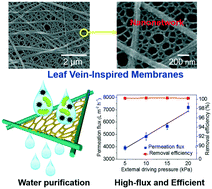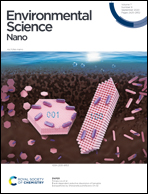Leaf vein-inspired microfiltration membrane based on ultrathin nanonetworks†
Abstract
The increasing worldwide contamination of freshwater by pathogenic microbes is one of the key global challenges facing public health. The commonly used technologies are often limited either by non-recyclability or deterioration of porous structures. Herein, an innovative leaf vein-inspired membrane (LVIM) by a nanonetwork structure is constructed by combining vapor-induced phase separation with electrospinning. Through exquisite control of solvents and relative humid conditions, our approach allows the continuous nanoscale network (∼45 nm fiber diameter) to strongly bind with electrospun nanofibers. The resulting LVIMs exhibit integrated properties of desirable pore structures (small pore size of 0.19 μm, high porosity of 93.2%, and favorable interconnectivity) and strikingly low membrane thickness (∼700 nm). Consequently, the LVIMs are capable of effectually capturing sub-micron particles (∼0.3 μm TiO2 particles) with high efficiency of 99.75% and robust permeation flux of 3907 L m−2 h−1 under an ultralow driving pressure of 5 KPa. More significantly, an outstanding bacterial removal efficiency for E. coli (log reduction value of 8.0) with twice the higher permeation flux (1206 L m−2 h−1) than the commercial microfiltration membranes was also achieved for LVIMs. The successful construction of such versatile membranes may act as an inspirational source for the design of next-generation high-performance separation membranes for various separation applications.

- This article is part of the themed collection: Nanomaterial applications in water


 Please wait while we load your content...
Please wait while we load your content...